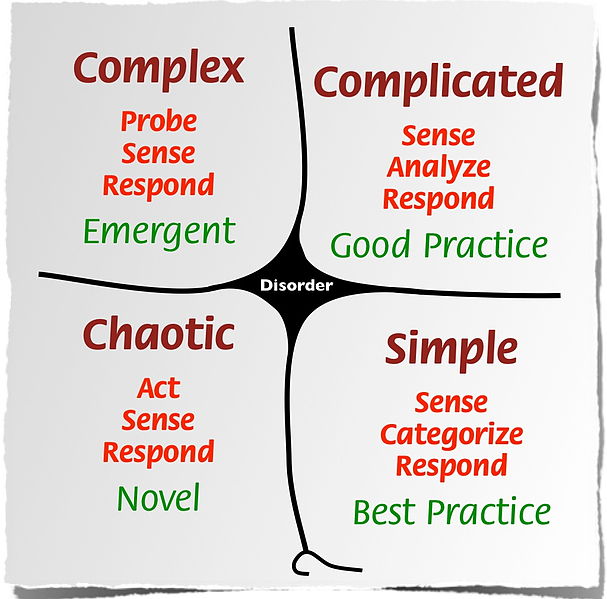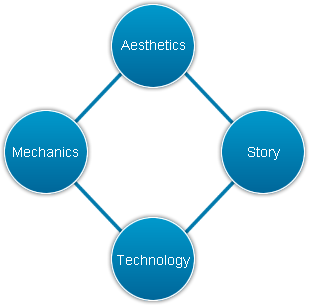Adapt and Evolve Your Gamification Through Jesse Schell’s Four Pillars of Design
Jesse Schell describes in his brilliant book The Art of Game Design the four pillars that is comprised of a game: Technology, Aesthetics, Mechanics, and Story/Narrative. When gamifying a process it is smart not to overlook any of the pillars. After all, we’re now in the experience economy and Gamification might be your killer app when enhancing customer or employee engagement:

A major difference with designing a game and gamifying a process is that a game designer tends to start from scratch. A gamification process already has a group of people, a corporate culture, a company brand etc. When gamifying, don’t be too idealistic, but become more pragmatic instead. Work with the materials you have and build something from there, don’t focus first on a vision and then try to make the world fit to it. Be like the chef that can make a great meal from random ingredients in the kitchen, not the recipe book user that will fail when an ingredient is not available.
A great metaphor for this need of thinkering can be seen in the movie Apollo 13:
Game Mechanics:
Many people who are a lot more knowledgeable than I have already explained this topic in great detail so I’ll not paraphrase them, but I do think there’s an insight I can make: Find out in what type of system you’re working in. This is a general problem in business management where they apply the wrong management style for the type of system their team finds itself in.
There are two basic types of system, open and closed, and each system requires its own managerial approach. In closed systems quantified approaches like Six Sigma and best practice work very well since the system is linear and predictable. One example of these is the manufacturing processes of a business. But when you apply Six Sigma and best practice to open systems that are non-linear and unpredictable, like the service sector, it fails miserably.
Similarly to the need of different managerial approaches, I believe different Gamification styles for opened and closed systems must be applied. If you constrain behavior by quantifying too much in an open and uncertain environment your organization won’t be able to make subtle adaptations to cope with a changing business ecology. One of the greatest allies in Gamification in the near future might come from Complexity Science where complex adaptive systems in enterprises gain insight from MMO guilds.
My favorite reference for understanding these systems is the Cynefin Model:

So trying to gamify in a complex system (open system) has very different rules than those in a simple system (closed system). If this doesn’t make complete sense don’t worry, I’ll explain how emergence practice can be used in both education and enterprise in follow up posts in this website so be sure to stay up to date with our developments. If you’re familiar with the Lean Startup method by Eric Ries you’ll be able to pick it up really quickly.
Aesthetics:
Do not be naive and believe that Gamification means applying “fun themes.” This is not a mistake game designers make; a rated E videogame is not going to have the same theme as rated M. Different industries have different cultures. You don’t want to tell Wall Street to start dressing like Google. Also, “doom and gloom” might make a more productive workforce in some sectors; gamification is not a cookie cutter. Focus on what experience you’re trying to create and the materials you’re working with! Not all movies are happy comedies.
Technology:
Gamified technology can vary from a teacher using monopoly in the classroom to big data software. Since all businesses today are technology businesses separated by a matter of degree, it’s indispensable to be familiar with Informational Technology. Enterprise Games by Michael Hugos is a great reference on combining game mechanics with IT and cloud computing.
This pillar is very interesting because in “Gamified” processes human beings are the main agents in the organization and technology is amplifying their intelligence, as opposed to technology replacing people. There’s a belief held by some people that computers will be able to predict and manage everything in the near future through algorithms. This will happen in closed systems, but human interpretation and agency will be the foundation in opened systems.
Story/Narrative:
The narrative can have many different contexts. It might bring emotional hooks that drive consumer loyalty or employee engagement, like “Made in USA” or manufacturing with recycled materials to save the planet. It might be for purely entertainment value to heighten the consumer experience (like Disneyland).
Jesse Schell describes that a necessary facet for turning a work activity into play is a “playful attitude.” He described how an assembly line worker had fun in his job by turning it into a game. What turned his work into a game was the need to answer a question: “Can I improve my record time today?” Thus a narrative might put the user in the correct mental framework to allow your gamified process to work.
One of my contemporary intellectual heroes is Dave Snowden who has done extensive work on how narratives affect socio-technological systems. Anthropology describes two types of cultures: Rule based and ideation based. Rule base is explicit, rules are written down. Ideation based is tacit; people follow certain patterns of behavior and values but can’t really articulate them. Ideation based cultures are established by the groups behavioral patterns and stories.
Dave Snowden makes an argument in favor of ideation based cultures: “At its heart an ideation culture will trump a rule based culture all the time.” In the same article he writes how to manage these ideation based cultures in enterprise:
“So how do we manage an ideation based culture? Well the first and most critical lesson is that we have to manage in the here and now, not some idealistic future state. That means we have to start with mapping the current culture, discovering the dominant beliefs, the proto-myths and the evolutionary possibilities: which directions are possible, not which goal would we like to achieve.”
Dave Snowden developed a software called the SenseMaker through which he has done extensive work mapping the cultures for government and enterprise:
So in a nutshell he asks people to tell stories and records them. The people telling these stories explain their meaning, as opposed to some “expert” telling us what we should learn from them. He is then able to map the underlying belief and value system of that culture, and which of these beliefs we are able to amplify or destroy, and those that are so rooted we’re unable to change.
I think there exists a possible combination between Jesse Schell’s insight and Dave Snowdens practice. Perhaps it’s possible that an ideation based culture could be created and managed through SenseMaker with the goal to create a “playful attitude” through a tacit set of values and beliefs. John Seely Brown describes how such a culture inspired by games could be adopted by the corporate world in a video titled “How World of Warcraft Could Save Your Business and The Economy”
This is an extensive topic and it will take a lot more to fully comprehend Dave’s narrative approach. What it does show though, is that there’s very credible people that has turn narrative in enterprises and government into a science with real world applications. Gamification is still young, and there are many tools yet to be explored and developed by its community.









Very exciting and one of the best point of view about gamification I ever seen. Thank you very much, I think playing games is the perfect medium to set up an ideation based culture. First Rules > then Playing to test them > Modify&Hacking these first Rules > finally Placing Myths and Ideology. All of these elements are close related with implicit motivation.
I’m glad you like it! I think “emergent gamification” (if I’m allowed to make up that term) will be one style that will become popular in the near future. A great example comes from an awesome lady called Constance Steinkuehler. She’s been advising the Obama administration on her research. If you got any questions contact me on my social media accounts, here’s a clip on Constance: https://www.youtube.com/watch?v=HzUnp5hS-2I
Nice article! Jesse Schell is a great professor!